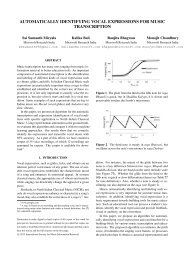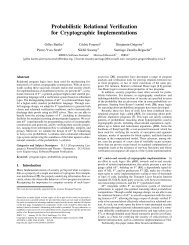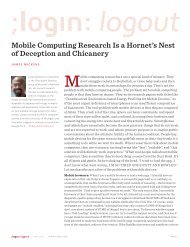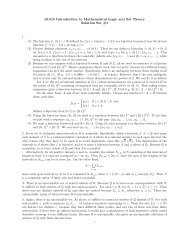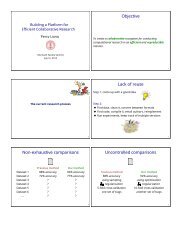Conversations in the Crowd - Microsoft Research
Conversations in the Crowd - Microsoft Research
Conversations in the Crowd - Microsoft Research
You also want an ePaper? Increase the reach of your titles
YUMPU automatically turns print PDFs into web optimized ePapers that Google loves.
While fur<strong>the</strong>r <strong>in</strong>vestigation is needed, our <strong>in</strong>itial results<br />
suggest that this is a feasible approach for collect<strong>in</strong>g<br />
task-oriented dialog data. We discuss future steps to<br />
improve <strong>the</strong> efficiency of data collection with <strong>the</strong> system.<br />
We conclude with a discussion of ongo<strong>in</strong>g work<br />
on provid<strong>in</strong>g tra<strong>in</strong><strong>in</strong>g data for spoken language understand<strong>in</strong>g<br />
models by hav<strong>in</strong>g <strong>the</strong> crowd collectively parse<br />
logs from <strong>the</strong> conversation <strong>in</strong>to <strong>the</strong>ir correspond<strong>in</strong>g semantic<br />
frames. Our work suggests a possible future <strong>in</strong><br />
which <strong>the</strong> crowd can be used to <strong>in</strong>creas<strong>in</strong>gly automate<br />
<strong>the</strong> process of build<strong>in</strong>g dialog systems <strong>in</strong> new doma<strong>in</strong>s,<br />
on-demand, with m<strong>in</strong>imal effort from developers.<br />
Background<br />
Our approach draws from rich prior work <strong>in</strong> both conversational<br />
dialog systems, and crowdsourc<strong>in</strong>g.<br />
Conversational Dialog Systems<br />
Our ChatCollect system is designed to alleviate <strong>the</strong><br />
development efforts for dialog systems. The manual<br />
author<strong>in</strong>g of <strong>the</strong>se systems has been recognized as a<br />
time consum<strong>in</strong>g effort that requires doma<strong>in</strong> expertise<br />
(Ward and Pellom 1999). This challeng<strong>in</strong>g and timeconsum<strong>in</strong>g<br />
process has been used <strong>in</strong> <strong>the</strong> development<br />
of many dialog systems (e.g., (Gandhe et al. 2009;<br />
Aleven et al. 2006; Allen et al. 1996)). Alternative approaches<br />
have focused on learn<strong>in</strong>g from transcribed<br />
human-human dialogs (Gor<strong>in</strong>, Riccardi, and Wright<br />
1997) or dialogs collected through Wizard-of-Oz studies<br />
(Lathrop 2004). However, exist<strong>in</strong>g human-human corpora<br />
apply to limited doma<strong>in</strong>s, and collect<strong>in</strong>g data for<br />
new doma<strong>in</strong>s with <strong>the</strong> exist<strong>in</strong>g techniques is difficult<br />
and expensive. Moreover, <strong>the</strong>y do not scale well – an<br />
important aspect given <strong>the</strong> amount of data needed to<br />
tra<strong>in</strong> accurate models for dialog systems. The system<br />
proposed <strong>in</strong> this paper holds promise for obta<strong>in</strong><strong>in</strong>g natural<br />
dialog data for various doma<strong>in</strong>s with little to no<br />
<strong>in</strong>volvement from system designers. The approach may<br />
enable automated tra<strong>in</strong><strong>in</strong>g of future dialog systems and<br />
speed up <strong>the</strong> real-world deployment of such systems.<br />
<strong>Crowd</strong>sourc<strong>in</strong>g<br />
<strong>Crowd</strong>sourc<strong>in</strong>g has ga<strong>in</strong>ed immense popularity <strong>in</strong> recent<br />
years as a means to provide programmatic, easy,<br />
and scalable access to human <strong>in</strong>telligence. <strong>Crowd</strong>sourc<strong>in</strong>g<br />
has been applied to a large variety of tasks rang<strong>in</strong>g<br />
from search relevance (Chen et al. 2013) to image description<br />
(Bigham et al. 2010). Recently, <strong>the</strong>re has been<br />
grow<strong>in</strong>g <strong>in</strong>terest <strong>in</strong> apply<strong>in</strong>g crowdsourc<strong>in</strong>g to language<br />
problems. <strong>Crowd</strong>sourc<strong>in</strong>g tasks have been designed for<br />
speech transcription (Lasecki et al. 2012), speech acquisition<br />
(Lane et al. 2010), translation (Zaidan and<br />
Callison-Burch 2011) and paraphrase generation (Burrows,<br />
Potthast, and Ste<strong>in</strong> 2013). Some prior work has<br />
particularly focused on crowdsourc<strong>in</strong>g methods for <strong>the</strong><br />
development of dialog systems. Wang et. al. studied<br />
methods for elicit<strong>in</strong>g natural language for a given semantic<br />
form (Wang et al. 2012). The Asgard system<br />
uses crowdsourc<strong>in</strong>g for free-form language generation<br />
and for <strong>the</strong> semantic label<strong>in</strong>g of segments of <strong>the</strong> collected<br />
language (Liu et al. 2013). Bessho et. al. (Bessho,<br />
Harada, and Kuniyoshi 2012) developed a dialog system<br />
that requests efforts from a real-time crowd to make<br />
progress <strong>in</strong> a dialog when automated approaches fail.<br />
Cont<strong>in</strong>uous real-time crowdsourc<strong>in</strong>g was <strong>in</strong>troduced<br />
by Lasecki et. al (Lasecki et al. 2011) <strong>in</strong> order to create<br />
crowd-powered systems capable of <strong>in</strong>teract<strong>in</strong>g with<br />
<strong>the</strong>ir users and <strong>the</strong>ir environment. This approach was<br />
applied to conversational <strong>in</strong>teraction <strong>in</strong> Chorus (Lasecki<br />
et al. 2013b; 2013a), a conversational question answer<strong>in</strong>g<br />
system. Both of <strong>the</strong>se systems are able to quickly get<br />
<strong>in</strong>put from crowd workers by pre-recruit<strong>in</strong>g (Bigham et<br />
al. 2010; Bernste<strong>in</strong> et al. 2011). ChatCollect differs from<br />
<strong>the</strong>se systems by recruit<strong>in</strong>g all sides of <strong>the</strong> dialog from<br />
<strong>the</strong> crowd for automated dialog generation.<br />
ChatCollect System<br />
The ChatCollect system is designed to collect realistic<br />
task-oriented dialog data from crowd workers. The<br />
only <strong>in</strong>puts of <strong>the</strong> system developer to <strong>the</strong> ChatCollect<br />
system are <strong>the</strong> different tasks <strong>the</strong> developer wants to<br />
collect data about. For example, a developer may tell<br />
ChatCollect to collect data about flight reservations,<br />
plann<strong>in</strong>g a night out or decid<strong>in</strong>g what car to buy.<br />
The ChatCollect system hires a pair of workers from a<br />
crowdsourc<strong>in</strong>g marketplace <strong>in</strong> real-time and l<strong>in</strong>ks <strong>the</strong>m<br />
to an <strong>in</strong>stant-messenger style chat w<strong>in</strong>dow to have a<br />
conversation about <strong>the</strong> given task, and assigns a role to<br />
each worker. The first worker routed to <strong>the</strong> chat w<strong>in</strong>dow<br />
is assigned <strong>the</strong> role of <strong>the</strong> “Assistant” and is <strong>in</strong>structed<br />
to help someone with <strong>the</strong> task at hand, such as f<strong>in</strong>d<strong>in</strong>g<br />
a flight. The second worker is assigned <strong>the</strong> role of<br />
<strong>the</strong> “User” and is given a task type to complete with<br />
<strong>the</strong> help of <strong>the</strong> Assistant (e.g., f<strong>in</strong>d flight). In order to<br />
add realistic depth to <strong>the</strong> conversations held by workers<br />
play<strong>in</strong>g a part, <strong>the</strong> system does not prime <strong>the</strong> User<br />
with <strong>the</strong> details of <strong>the</strong> task she needs to complete, but<br />
<strong>in</strong>stead it asks <strong>the</strong> User to imag<strong>in</strong>e such a sett<strong>in</strong>g. Both<br />
workers are <strong>in</strong>structed not to share any personally identifiable<br />
<strong>in</strong>formation about <strong>the</strong>mselves.<br />
S<strong>in</strong>ce <strong>the</strong> Assistant is hired first and routed to <strong>the</strong><br />
chat <strong>in</strong>terface, <strong>the</strong> User f<strong>in</strong>ds <strong>the</strong> Assistant wait<strong>in</strong>g<br />
when she is routed to <strong>the</strong> chat <strong>in</strong>terface. The User is<br />
<strong>in</strong>structed to start <strong>the</strong> dialog when she is at <strong>the</strong> chat<br />
<strong>in</strong>terface by tell<strong>in</strong>g <strong>the</strong> Assistant about <strong>the</strong> task. The<br />
User and Assistant both share <strong>in</strong>formation about <strong>the</strong><br />
task, discuss possible solutions, and revise <strong>the</strong> task.<br />
Workers are asked to complete <strong>the</strong> task as well as<br />
possible (ra<strong>the</strong>r than meet <strong>the</strong> m<strong>in</strong>imum requirements,<br />
or just accept any response). Once <strong>the</strong> User deems that<br />
<strong>the</strong> task is complete, she can signal <strong>the</strong> end of <strong>the</strong> <strong>in</strong>teraction<br />
by click<strong>in</strong>g “done”, which forwards her and<br />
<strong>the</strong> Assistant worker to a survey page ask<strong>in</strong>g <strong>the</strong>m each<br />
about <strong>the</strong> quality of <strong>the</strong> <strong>in</strong>teraction <strong>the</strong>y had. The survey<br />
also asks <strong>the</strong> Assistant workers about <strong>the</strong> resources<br />
(e.g., websites) <strong>the</strong>y used to complete <strong>the</strong> given task.



